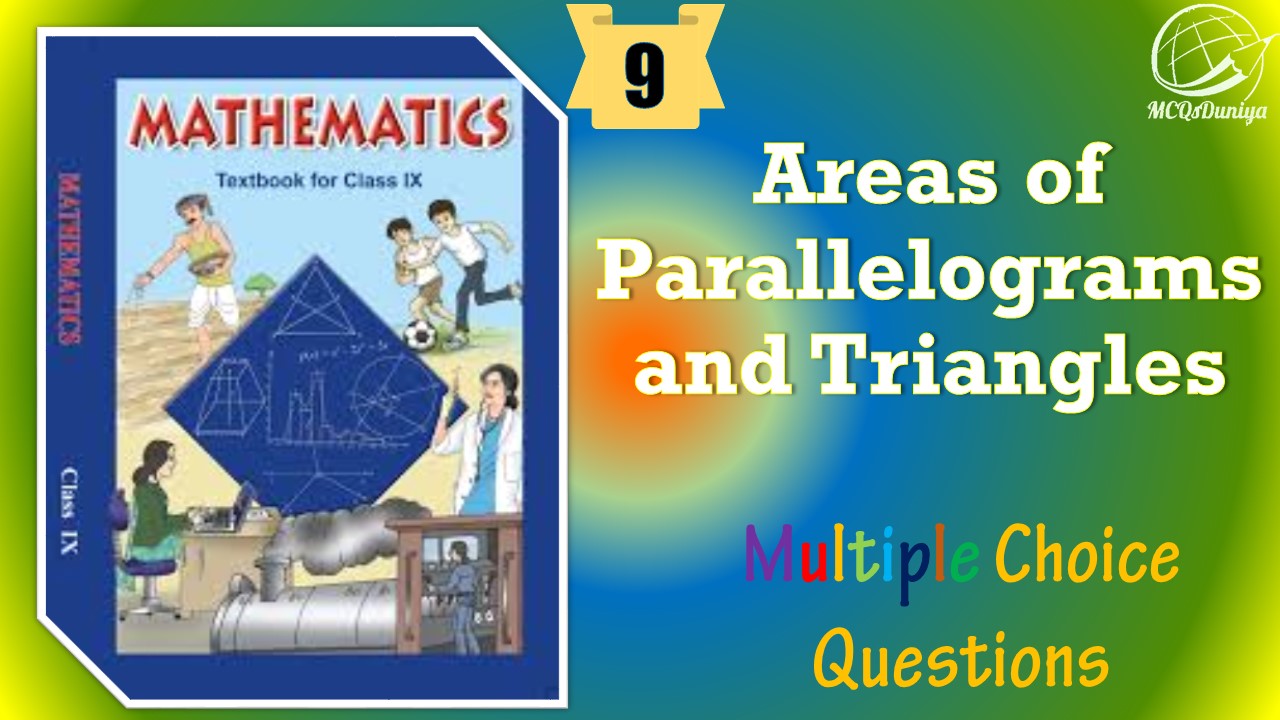Class 9 Mathematics MCQ Area Of Parallelograms And Triangles with Answers is Prepared Based on Latest Exam Pattern. Students can solve NCERT Class 9 Mathematics MCQ Area Of Parallelograms And Triangles with Answers to know their preparation level.
Students who are searching for NCERT Class 9 Mathematics MCQ Area Of Parallelograms And Triangles with Answers are compiled here to get good practice on all fundamentals. Know your preparation level on MCQ Questions for Class 9 Mathematics MCQ Area Of Parallelograms And Triangles with Answers. You can also verify your answers from the provided Class 9 Mathematics MCQ Area Of Parallelograms And Triangles with Answers. So, ace up your preparation with MCQ of Class 9 Mathematics MCQ & NCERT Textbook solutions Examinations.
NCERT Class 9 Mathematics MCQ Area Of Parallelograms And Triangles with Answers
Question :If P and Q are any two points lying on the sides DC and AD respectively of a parallelogram ABCD, then:
(a) ar(APB) > ar(BQC)
(b) ar(APB) < ar(BQC)
(c) ar(APB) = ar(BQC)
(d) None of the above
Answer : (c) ar(APB) = ar(BQC)Show Answer :
Question : The median of a triangle divides it into two
(a) congruent triangles.
(b) isosceles triangles.
(c) right angles.
(d) triangles of equal areas
Answer :(d) triangles of equal areasShow Answer :
Question : A median of a triangle divides it into two triangles of
(a) Unequal area
(b) Each one-fourth of the area of the given triangle.
(c) Equal sides
(d) Equal area
Answer :(d) Equal areaShow Answer :
Question : The median of a triangle divides it into two
(a) congruent triangles.
(b) isosceles triangles.
(c) right angles.
(d) triangles of equal areas
Answer :(d) triangles of equal areasShow Answer :
Question : AE is a median to side BC of triangle ABC. If area(ΔABC) = 24 cm, then area(ΔABE) =
(a) 8 cm
(b) 12 cm
(c) 16 cm
(d) 18 cm
Answer :(b) 12 cmShow Answer :
Question : What is the area of a parallelogram?
(a) ½ × Base × Altitude
(b) Base × Altitude
(c) ¼ × Base × Median
(d) Base × Base
Answer :(b) Base × AltitudeShow Answer :
Question : The area of a right triangle is 30 sq cm. If the base is 5 cm, then the hypotenuse must be
(a) 12 cm
(b) 18 cm
(c) 13 cm
(d) 20 cm
Answer :(c) 13 cmShow Answer :
Question : D,E,F are mid points of the sides BC, CA & AB respectively of ΔABC, then area of BDEF is equal to
(a) 1/2ar (ΔABC)
(b) 1/4ar (ΔABC)
(c) 1/3ar (ΔABC)
(d) 1/6ar (ΔABC)
Answer :(a) 1/2ar (ΔABC)Show Answer :
Question :A triangle and a rhombus are on the same base and between the same parallels. Then the ratio of area of triangle to that rhombus is:
(a) 1 : 3
(b) 1 : 2
(c) 1 : 1
(d) 1 : 4
Answer : (b) 1 : 2Show Answer :
Question :Two parallelograms are on equal bases and between the same parallels. The ratio of their areas is
(a) it is 1 : 1.
(b) it is 1 : 2.
(c) it is 3 : 1.
(d) it is 2 : 1.
Answer : (a) it is 1 : 1.Show Answer :
Question :or two figures to be on the same base and between the same parallels ,they must have a common base and.
(a) One common vertex
(b) The vertices(or the vertex) opposite to the common base lying on a line parallel to the base
(c) The vertices(or the vertex) opposite to the common base lying on a line making an acute angle to the base
(d) Two common vertices
Answer : (b) The vertices(or the vertex) opposite to the common base lying on a line parallel to the baseShow Answer :
Question :The median of a triangle divides it into two
(a) congruent triangles.
(b) isosceles triangles.
(c) right angles.
(d) triangles of equal areas
Answer : (d) triangles of equal areasShow Answer :
Question :If a triangle and a parallelogram are on the same base and between the same parallels, then the ratio of the area of the triangle to the area of the parallelogram is
(a) it is 1 : 4.
(b) it is 3 : 1.
(c) it is 1 : 2.
(d) it is 1 : 4.
Answer : (c) it is 1 : 2.Show Answer :
Question :The area of a right triangle is 30 sq cm. If the base is 5 cm, then the hypotenuse must be
(a) 12 cm
(b) 18 cm
(c) 13 cm
(d) 20 cm
Answer : (c) 13 cmShow Answer :
Question :D,E,F are mid points of the sides BC, CA & AB respectively of ΔABC, then area of BDEF is equal to
(a)
(b)
(c)
(c)
Answer : (a) Show Answer :
Question :Area of a trapezium, whose parallel sides are 9 cm and 6 cm respectively and the distance between these sides is 8 cm, is
(a) 80 cm2
(b) 30 cm2
(c) 120 cm2
(d) 60 cm2
Answer : (d) 60 cm2Show Answer :
Question :A median of a triangle divides it into two
(a) Congruent triangles
(b) Isosceles triangles
(c) Right triangles
(d) Equal area triangles
Answer : (d) Equal area trianglesShow Answer :
Question : AE is a median to side BC of triangle ABC. If area(ΔABC) = 24 cm, then area(ΔABE) =
(a) 8 cm
(b) 12 cm
(c) 16 cm
(d) 18 cm
Answer :(b) 12 cmShow Answer :
Question : If P and Q are any two points lying on the sides DC and AD respectively of a parallelogram ABCD, then:
(a) ar(APB) > ar(BQC)
(b) ar(APB) < ar(BQC)
(c) ar(APB) = ar(BQC)
(d) None of the above
Answer :(c) ar(APB) = ar(BQC)Show Answer :
Question : ABCD is a quadrilateral whose diagonal AC divides it in two parts of equal area, then ABCD is a
(a) rectangle
(b) rhombus
(c) parallelogram
(d) need not be any of (i), (ii) or (iii)
Answer :(d) need not be any of (i), (ii) or (iii)Show Answer :
Question : A median of a triangle divides it into two
(a) Congruent triangles
(b) Isosceles triangles
(c) Right triangles
(d) Equal area triangles
Answer :(d) Equal area trianglesShow Answer :
Question : Parallelogram ABCD and rectangle ABEF are on the same base AB. If AB = 14 cm, BC = 12 cm, then the possible value for the perimeter of ABEF is
(a) 52
(b) 64
(c) 48
(d) 59
Answer :(a) 52Show Answer :
Question : If Diagonals AC and BD of a trapezium ABCD with AB || DC intersect each other at O. Then,
(a) ar (AOD) = ar (BOC)
(b) ar (AOD) > ar (BOC)
(c) ar (AOD) < ar (BOC)
(d) None of the above
Answer :(a) ar (AOD) = ar (BOC)Show Answer :
Question : In a triangle ABC, E is the mid-point of median AD. Then:
(a) ar(BED) = 1/4 ar(ABC)
(b) ar(BED) = ar(ABC)
(c) ar(BED) = 1/2 ar(ABC)
(d) ar(BED) = 2 ar(ABC)
Answer :(a) ar(BED) = 1/4 ar(ABC)Show Answer :
Question : The median of a triangle divides it into two
(a) isosceles triangle
(b) congruent triangles
(c) right angled triangle
(d) triangles of equal areas
Answer :(d) triangles of equal areasShow Answer :
Question : Area of a trapezium, whose parallel sides are 9 cm and 6 cm respectively and the distance between these sides is 8 cm, is
(a) 80 cm²
(b) 30 cm²
(c) 120 cm²
(d) 60 cm²
Answer :(d) 60 cm²Show Answer :
Question : The area of the figure formed by joining the mid-points of the adjacent sides of a rhombus with diagonals 16 cm and 12 cm is
(a) 24cm²
(b) 48m²
(c) 28m²
(d) 96m²
Answer :(b) 48m²Show Answer :
Question :What is the area of a parallelogram?
(a)
(b) Base × Altitude
(c)
(d) Base × Base
Answer : (b) Base × AltitudeShow Answer :
Question :AE is a median to side BC of triangle ABC. If area(ΔABC) = 24 cm, then area(ΔABE) =
(a) 8 cm
(b) 12 cm
(c) 16 cm
(d) 18 cm
Answer : (b) 12 cmShow Answer :
Question : If Diagonals AC and BD of a trapezium ABCD with AB || DC intersect each other at O. Then,
(a) ar (AOD) = ar (BOC)
(b) ar (AOD) > ar (BOC)
(c) ar (AOD) < ar (BOC)
(d) None of the above
Answer : aShow Answer :
Explanation: △DAC and △DBC lie on the same base DC and between the same parallels AB and CD.
ar(△DAC) = ar(△DBC)
⇒ ar(△DAC) − ar(△DOC) = ar(△DBC) − ar(△DOC)
⇒ ar(△AOD) = ar(△BOC)
Question : If Diagonals AC and BD of a quadrilateral ABCD intersect at O in such a way that ar(△AOD) = ar(△BOC). Then ABCD is a:
(a) Parallelogram
(b) Rectangle
(c) Square
(d) Trapezium
Answer : dShow Answer :
Explanation:
ar(△AOD) = ar(△BOC)
⇒ ar(△AOD) + ar(△AOB) = ar(△BOC) + ar(△AOB)
⇒ ar(△ADB) = ar(△ACB)
Areas of △ADB and △ACB are equal.
Therefore, they must lie between the same parallel lines.
Therefore, AB ∥ CD
Hence, ABCD is a trapezium.
Question : Two parallelograms are on equal bases and between the same parallels. The ratio of their areas is
(a) 1: 1
(b) 1: 2
(c) 2: 1
(d) 3: 1
Answer :aShow Answer :
Explanation: We know that the parallelogram on equal bases and between the same parallels are equal in area. Hence, the ratio of their areas is 1 :1.
Let the area of the first parallelogram be P1 and the area of the second parallelogram be P2.
We know the Area of parallelogram = b×h
⇒ P1 = b1 × h1
⇒ P2 = b2 × h2
⇒ b1 = b2 [ As per the question]
⇒ h1 = h2 [ As the distance between two parallel lines is always equal ]
∴ P1 = b × h —— (1)
∴ P2 = b × h —— (2)
By equating ( 1 ) and ( 2 ) we get,
⇒ P1 = P2
⇒ P1😛2
= 1:1 [As cancelling same area P1 and P2 ]
Question : The mid-point of the sides of a triangle along with any of the vertices as the fourth point make a parallelogram of area equal to:
(a) ar (ABC)
(b) (1/2) ar(ABC)
(c) (1/3) ar(ABC)
(d) (1/4) ar(ABC)
Answer :bShow Answer :
Explanation:
Now, consider a triangle ABC as shown in the figure.
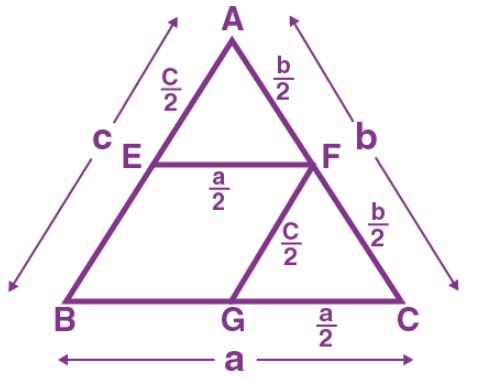
Let the area of the triangle be “A”.
By using Heron’s formula
Therefore, the area of triangle AEF = A/4
Area of triangle CFG = A/4
Therefore, the area of parallelogram BEFG = Area of triangle ABC – Area of AEF – Area of CFG
= A – (A/4) – (A/4)
= (4A – A – A)/4
= 2A/4
=(½) A.
Hence, option (B) is the correct answer.
Question : The area of a parallelogram with base “b” and height “h” is
(a) b×h square units
(b) b2 square units
(c) h2 square units
(d) b+h square units
Answer :aShow Answer :
Explanation: The area of a parallelogram with base “b” and height “h” is b×h.(i.e) A = base × height square units.
Question : ABCD is a quadrilateral whose diagonal AC divides it into two parts, equal in area, then ABCD
(a) is always a rhombus
(b) is a rectangle
(c) is a parallelogram
(d) need not be any of (A), (B) or (C)
Answer :dShow Answer :
Explanation: A quadrilateral ABCD need not be any of rhombus, parallelogram or rectangle. If ABCD is a square, its diagonal AC divides it into two parts and is equal in area.
Question : If a triangle and a parallelogram are on the same base and between same parallels, then the ratio of the area of the triangle to the area of the parallelogram will be:
(a) 1:2
(b) 3:2
(c) 1:4
(d) 1:3
Answer : aShow Answer :
Explanation:
Triangle and parallelogram are on the same base and between the same parallels.
If a triangle and a parallelogram are on the same base and between the same parallels, then the area of a triangle is equal to half the area of the parallelogram.
In the adjoining figure, parallelogram ABCD and △ABD are on the same base AB and between the same parallels AF and DC.
∴ area of △ABD = ½ area of parallelogram ABCD
⇒ area of △ABD = ½ (AB×AE) [∵ DE is the altitude of parallelogram ABCD]
Here, AB is the base and AE is the height of △ABD.
So, the ratio of the area of the triangle to the area of the parallelogram will be 1:2
Question : The area of the figure formed by joining the mid-points of the adjacent sides of a rhombus with diagonals 12 cm and 16 cm is
(a) 48 cm2
(b) 96 cm2
(c) 64 cm2
(d) 192 cm2
Answer :aShow Answer :
Explanation: Consider the rhombus ABCD as shown in the figure.
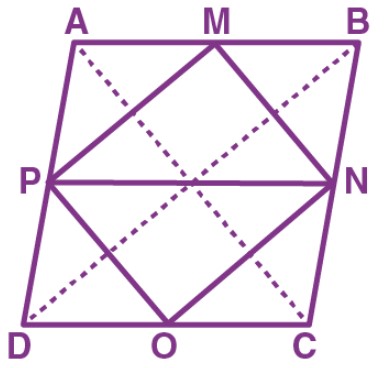
Now, join the midpoint of the sides AB, BC, CD and DA of a rhombus ABCD and mark them as M, N, O and P respectively to form a shape MNOP.
Now, join the points P and N to make a line PN. Hence, PN∥AB and PN∥DC
From the above diagram, parallelogram ABNP and triangle MNOP are on the same base PN and in between the same parallel lines PN and AB.
Now, by using the property, “if a triangle and a parallelogram are on the same base and between the same parallels, the area of the triangle is equal to one-half area of the parallelogram”. Hence, we can write
Area of ΔMNP= (½) Area of ABPN ………… (1)
Area of ΔPON=(½) Area of PNCD …………. (2)
Hence, the area of ABCD= (½)×d1×d2
By using (1) and (2), we get
Area of MNOP = Area of ΔMNP+ Area of ΔPON
=(½)area of ABPN+(½)area of PNDC
=½((½)×12×16) = 48cm2.
Question : Parallelogram is a:
(a) Pentagon
(b) Quadrilateral
(c) Heptagon
(d) Octagon
Answer :bShow Answer :
Explanation: Parallelogram is a quadrilateral, as it has four sides.
Question : The figure obtained by joining the mid-points of the adjacent sides of a rectangle of sides 8 cm and 6 cm is
(a) a square of area 25 cm2
(b) a rectangle of area 24 cm2
(c) a rhombus of area 24 cm2
(d) a trapezium of area 24 cm2
Answer :cShow Answer :
Explanation:

Let ABCD be a rectangle, and E, F, G and H are the midpoints of AB, BC, CD and DA respectively.
Hence, the figure obtained by joining the midpoints E, F, G and H is a rhombus.
Now, we need to find the area of the rhombus.
Since, the side lengths of the rectangle are given,
Diagonal of rhombus FH = Side length of the rectangle AB = 8 cm
Diagonal of rhombus EG = Side length of the rectangle AD = 6 cm
Therefore, the area of rhombus = (½)(AB)(AD)
= (½)(8)(6) = 48/2 = 24 cm2.
Question : The area of parallelogram ABCD for the following figure is

(a) BC × BN
(b) AB × BM
(c) DC × DL
(d) AD × DL
Answer :cShow Answer :
Explanation: The area of a parallelogram for the given figure is DC × DL, as the formula for the area of the parallelogram is base × height.
Question : If parallelogram ABCD and rectangle ABEM are of equal area for the given figure, then
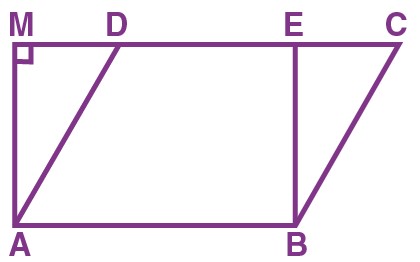
(a) Perimeter of ABCD = Perimeter of ABEM
(b) Perimeter of ABCD = (½) Perimeter of ABEM
(c) Perimeter of ABCD < Perimeter of ABEM
(d) Perimeter of ABCD > Perimeter of ABEM
Answer :dShow Answer :
Explanation: Perimeter of parallelogram ABCD is greater than the Perimeter of rectangle ABEM
Question : Triangles on the same base and between the same parallels are
(a) Greater in area
(b) Equal in area
(c) smaller in area
(d) None of the above
Answer :bShow Answer :
Explanation: Triangles on the same base and between the same parallels are equal in area.
Question :In the figure, ∠PQR = 90°, PS = RS, QP = 12 cm and QS = 6.5 cm. The area of ΔPQR is
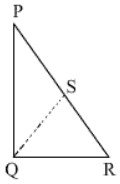
(a) 30 cm2
(b) 20 cm2
(c) 39 cm2
(d) 60 cm2
Answer : (a) 30 cm2Show Answer :
Question :BCD is quadrilateral whose diagonal AC divides it into two parts, equal in area, then ABCD
ABCD is quadrilateral whose diagonal AC divides it into two parts, equal in area, then ABCD
(a) is a rectangles
(b) is a parallelogram
(c) is a rhombus
(d) need not be any of (a), (b) or (c).
Answer : (d) need not be any of (a), (b) or (c).Show Answer :
Question :In ΔPQR, if D and E are points on PQ and PR respectively such that DE || QR, then ar (PQE) is equal to
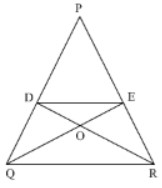
(a) ar (PRD)
(b) ar (DQM)
(c) ar (PED)
(d) ar (DQR)
Answer : (a) ar (PRD)Show Answer :
Question :If Diagonals AC and BD of a trapezium ABCD with AB || DC intersect each other at O. Then,
(a) ar (AOD) = ar (BOC)
(b) ar (AOD) > ar (BOC)
(c) ar (AOD) < ar (BOC)
(d) None of the above
Answer : (a) ar (AOD) = ar (BOC)Show Answer :
Question :For two figures to be on the same base and between the same parallels, one of the lines must be.
(a) Making an acute angle to the common base
(b) The line containing the common base
(c) Perpendicular to the common base
(d) Making an obtuse angle to the common base
Answer : (b) The line containing the common baseShow Answer :
Question :Two parallelograms are on equal bases and between the same parallels. The ratio of their areas is:
(a) 1 : 3
(b) 1 : 2
(c) 2 : 1
(d) 1 : 1
Answer : (d) 1 : 1Show Answer :
Question : Two parallelograms are on equal bases and between the same parallels. The ratio of their areas is:
(a) 1 : 3
(b) 1 : 2
(c) 2 : 1
(d) 1 : 1
Answer :(d) 1 : 1Show Answer :
Question : If D and E are points on sides AB and AC respectively of ΔABC such that ar(DBC) = ar(EB(iii) Then:
(a) DE is equal to BC
(b) DE is parallel to BC
(c) DE is not equal to BC
(d) DE is perpendicular to BC
Answer :(b) DE is parallel to BCShow Answer :
Question : D and E are the mid-points of BC and AD respectively. If ar(ΔABC) = 12 cm², then ar(ΔBDE) is
(a) 5 cm²
(b) 6 cm²
(c) 3 cm²
(d) 9 cm²
Answer :(c) 3 cm²Show Answer :
Question : If Diagonals AC and BD of a trapezium ABCD with AB || DC intersect each other at O. Then,
(a) ar (AOD) = ar (BOC)
(b) ar (AOD) > ar (BOC)
(c) ar (AOD) < ar (BOC)
(d) None of the above
Answer :(a) ar (AOD) = ar (BOC)Show Answer :
Question : ABCD is a quadrilateral P,Q,R and S are the mid-points of AB, BC, CD and DA respectively, then PQRS is a
(a) Square
(b) Parallelogram
(c) Trapezium
(d) Kite
Answer :(b) ParallelogramShow Answer :
Question : A triangle and a rhombus are on the same base and between the same parallels. Then the ratio of area of triangle to that rhombus is:
(a) 1 : 3
(b) 1 : 2
(c) 1 : 1
(d) 1 : 4
Answer :(b) 1 : 2Show Answer :
Question : If Diagonals AC and BD of a quadrilateral ABCD intersect at O in such a way that ar(△AOD) = ar(△BOC). Then ABCD is a:
(a) Parallelogram
(b) Rectangle
(c) Square
(d) Trapezium
Answer :(d) TrapeziumShow Answer :
Question : If ABCD is a parallelogram, AE ⊥ DC and CF ⊥ AD. If AB = 10 cm, AE = 6 cm and CF = 5 cm, then AD is equal to:
(a) 10cm
(b) 6cm
(c) 12cm
(d) 15cm
Answer : cShow Answer :
Explanation: Given,
AB = CD = 10 cm (Opposite sides of a parallelogram)
CF = 5 cm and AE = 6 cm
Now,
Area of parallelogram = Base × Altitude
CD × AE = AD × CF
10 × 6 = AD × 5
AD = 60/5
AD = 12 cm
Question : If E, F, G and H are the mid-points of the sides of a parallelogram ABCD, respectively, then ar (EFGH) is equal to:
(a) 1/2 ar(ABCD)
(b) ¼ ar(ABCD)
(c) 2 ar(ABCD)
(d) ar(ABCD)
Answer : aShow Answer :
Explanation: Join H and F as shown in the below figure:
AD || BC and AD = BC
½ AD = ½ BC
AH || BF and and DH || CF
AH = BF and DH = CF (H and F are midpoints)
∴, ABFH and HFCD are parallelograms.
ΔEFH and llgmABFH, both lie on a common base, FH.
∴ area of EFH = ½ area of ABFH — 1
area of GHF = 1/2area of HFCD — 2
Adding eq. 1 and 2 we get;
area of ΔEFH + area of ΔGHF = ½ (area of ABFH + area of HFCD)
ar (EFGH) = ½ ar(ABCD)
Question : If P and Q are any two points lying on the sides DC and AD respectively of a parallelogram ABCD, then:
(a) ar(APB) > ar(BQC)
(b) ar(APB) < ar(BQC)
(c) ar(APB) = ar(BQC)
(d) None of the above
Answer : cShow Answer :
Explanation: ΔAPB and parallelogram ABCD lie on the same base AB and in-between same parallel AB and DC.
ar(ΔAPB) = ½ ar(parallelogram ABCD) — 1
ar(ΔBQC) = ½ ar(parallelogram ABCD) — 2
From eq. 1 and 2:
ar(ΔAPB) = ar(ΔBQC)
Question : If ABCD and EFGH are two parallelograms between same parallel lines and on the same base, then:
(a) ar (ABCD) > ar (EFGH)
(b) ar (ABCD) < ar (EFGH)
(c) ar (ABCD) = ar (EFGH)
(d) None of the above
Answer : cShow Answer :
Explanation: We know that,
Area of a parallelogram = base ⨯ height
Now, if both parallelograms are on the same base and between the same parallels, then their heights will be equal.
Hence, their areas will also be equal.
∴ ar (ABCD) = ar (EFGH)
Question : A median of a triangle divides it into two
(a) Congruent triangles
(b) Isosceles triangles
(c) Right triangles
(d) Equal area triangles
Answer : dShow Answer :
Explanation: Suppose, ABC is a triangle and AD is the median.
AD is the median of ΔABC.
∴ It will divide ΔABC into two triangles of equal area.
∴ ar(ABD) = ar(ACD) — (i)
also,
ED is the median of ΔABC.
∴ ar(EBD) = ar(ECD) — (ii)
Subtracting (ii) from (i),
ar(ABD) – ar(EBD) = ar(ACD) – ar(ECD)
⇒ ar(ABE) = ar(ACE)
Question : In a triangle ABC, E is the mid-point of median AD. Then:
(a) ar(BED) = 1/4 ar(ABC)
(b) ar(BED) = ar(ABC)
(c) ar(BED) = 1/2 ar(ABC)
(d) ar(BED) = 2 ar(ABC)
Answer : aShow Answer :
Explanation:
ar(BED) = ½ BD.DE
AE = DE (E is the midpoint)
BD = DC (AD is the median on side BC)
DE = ½ AD ——– 1
BD = ½ BC ——– 2
From eq. 1 and 2, we get;
ar(BED) = (½ ) x (½) BC x (½) AD
ar(BED) = (½) x (½) ar(ABC)
ar(BED) = ¼ ar (ABC)
Question : If D and E are points on sides AB and AC respectively of ΔABC such that ar(DBC) = ar(EBC). Then:
(a) DE is equal to BC
(b) DE is parallel to BC
(c) DE is not equal to BC
(d) DE is perpendicular to BC
Answer : bShow Answer :
Explanation: ΔDBC and ΔEBC are on the same base BC and also have equal areas.
∴ They will lie between the same parallel lines.
∴ DE || BC.

